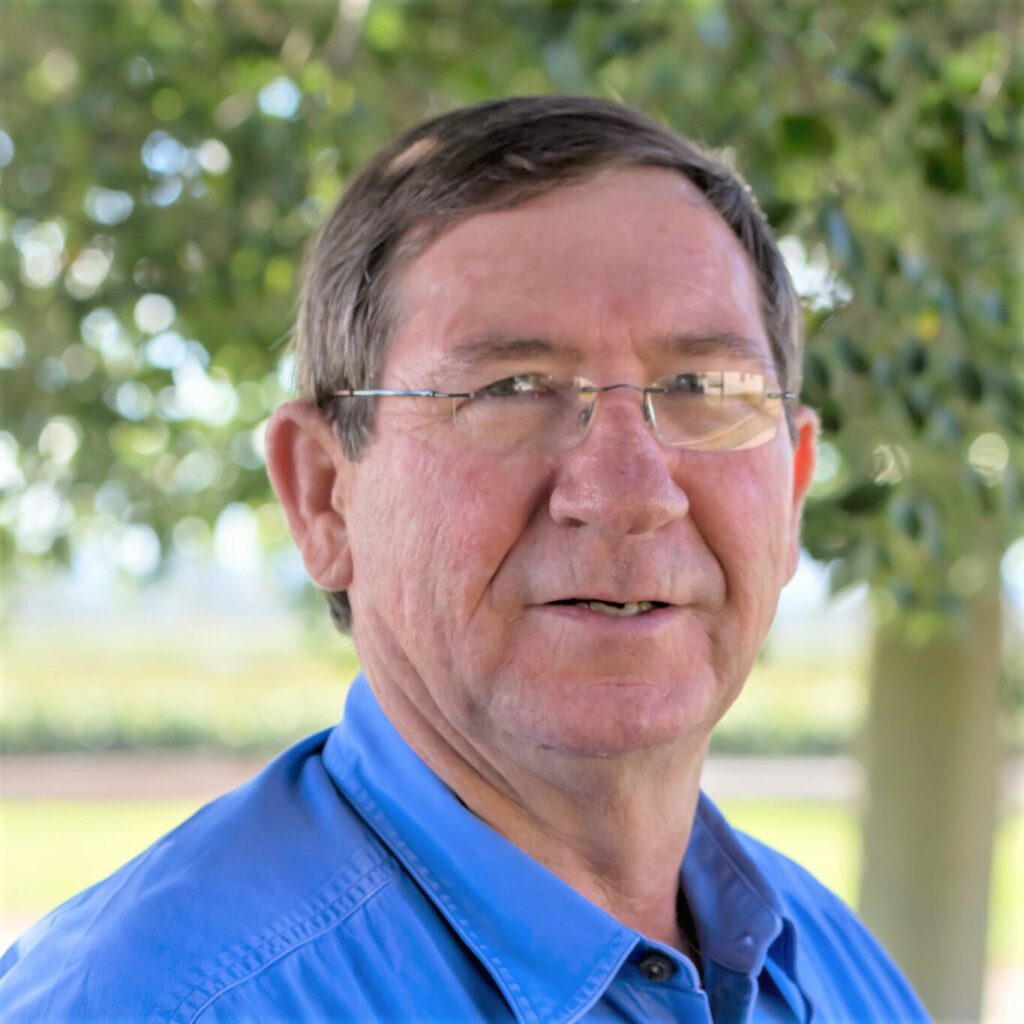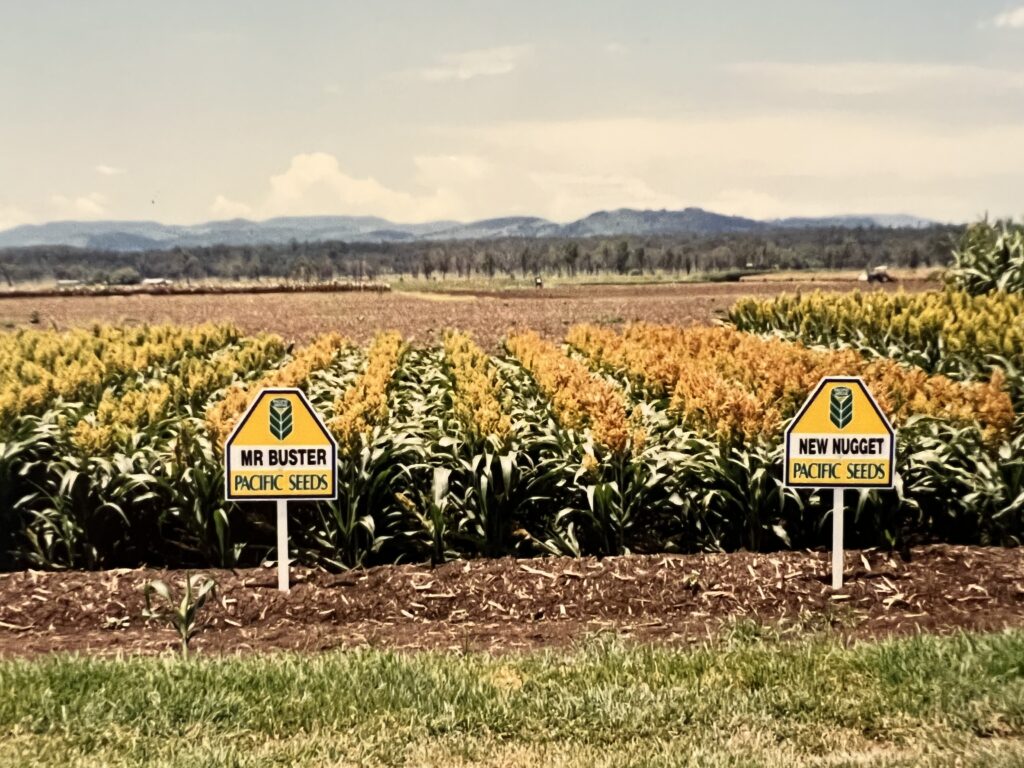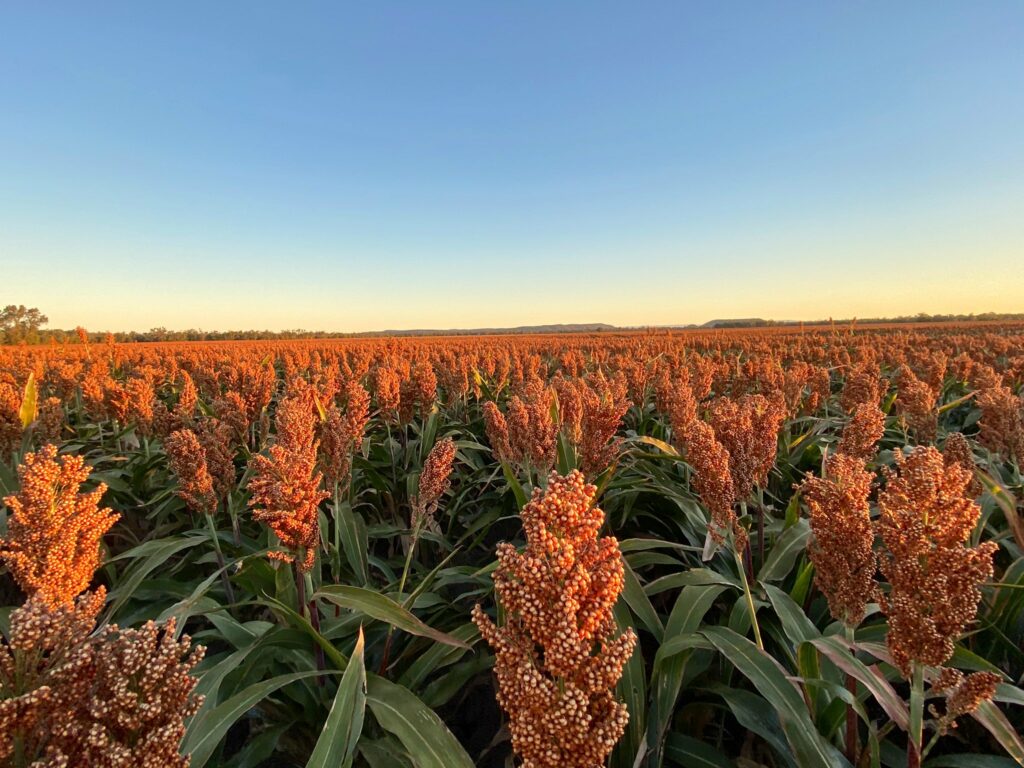A history of grain sorghum in Australia
March 11, 2024
Rob McCarron, Pacific Seeds Territory Manager reflects on the major highlights in the grain sorghum industry in his almost 42 years being involved with the seed industry.
Grain sorghum or Milo as it used to be known as, has been cultivated in Australia since the 1900’s as a form of stock feed, firstly in more northern or summer rainfall dominant locations. Today grain sorghum is a major component of the dryland cropping system of north-east Australia, comprising of some 200,000-950,000ha annually. Total production in 2022-23 was approximately 2,600,000t from 687,000 ha with the harvested product being both exported and used domestically for stockfeed.
The first cultivars grown in Australia were open pollinated and introduced from the United States of America (US) with several of these continuing to be used up until the development of the hybrid sorghum industry in the 1960’s. Cultivars such as Caprock, Martin, Wheatland and Alpha were commonly used and were further developed as the hybridisation of sorghum evolved. The early introductions tended not to be broadly adapted and often exhibited small grain, unreliable yields, longer maturity and were very prone to lodging.
With the advent of wheat quotas in the 1970’s, more interest was created for alternative crops to wheat, grain sorghum was one such crop. Seed companies saw potential inthe new crop, which drove US based seed companies to begin breeding and testing existing US hybrids.
Up until this point the crop was considered opportunistic and unreliable to grow in Australia, due to high planting rates of up to 10 lb per acre which (10 kg/ha or 300-400,000 seed/ha), the original open pollinated varieties had much smaller seed than today’s hybrids. Soil moisture was not stored well due to conventional fallows utilising tyned or disc implements, country was often cultivated and planted a few weeks apart.
Many hybrids introduced from the US were not adapted to the Australian environment. It was critical therefore, for seed companies to invest in local research and development to develop adaptable varieties. Early on there were eight seed companies servicing the local Australian market – Pacific Seeds, Hylan, Pioneer Hi-Bred, Dekalb Shand, Arthur Yates & Co., Cargill Seeds, Northrup King, and Asgrow.
Early hybrids were longer maturity, resulting in mixed harvested yields. Varieties E57 and DK 55 (Dekalb) were initially very popular but with lack of stored moisture and follow up rain, results varied.
Consistent results were achieved after the introduction of the quicker maturing hybrids Goldrush, Prize, Nugget, DK 38, and Pride, due to the lack of stored moisture on a consistent basis.
With the advent of hybrid grain sorghums to Australian farmers in the 1970’s, there was a rapid expansion of the area sown, particularly in the Central Highlands and Callide Dawson area of Queensland. Even into the Northern Territory at Scotts Creek where Bryce Killen undertook an ambitious program to grow sorghum during the wet season. In 1972/73 the operation reached its peak with almost 10,000 ha planted for a net return of 18,000 t of grain. Due to low grain prices, freight costs, heavy weed infestations the beef slump of the mid-seventies the operation went into receivership. This ended the production of grain sorghum in the Northern Territory. Well known Wellington based grain trader, Michael White remembers buying a parcel of this sorghum for just $16/t on farm!
By the early 1990’s the number of seed companies had reduced to four, with companies lacking local breeding programs closing or selling.
Even though grain sorghum hybrids delivered more reliable yields, there has been a contraction in the areas where grain sorghum is produced, particularly in New South Wales where there is lighter soil types and less reliable summer rainfall.

Once hybrids became the norm for sorghum growers closer attention was paid to the agronomic management, including; conserving soil moisture from long fallows; lowering seeding rates to 1.5-3 kg/ha; the use of fertilisers for increased production and herbicides for weed control.
The most important step forward in making grain sorghum a more reliable and in some cases, the most profitable crop grown, was the uptake of minimum and zero tillage. This single management change coupled with improved and more adaptable hybrids has improved yields dramatically in the past two decades.
During the same period farmers were replacing standard planting equipment with precision planters. This was another contributor to the improvement of sorghum production throughout north-eastern Australia. Moving away from the combine/airseeders into planters with depth control, seed singulation and placement has improved establishment and yield outcomes.
The next breakthrough for grain sorghum came in the 1980’s with the s incorporation of midge resistant hybrids. The first midge resistant hybrids had some draw backs, including longer maturity, smaller grain size and higher lodging propensity. Sorghum breeders worked hard to overcome these issues and testimony to their persistence is reflected in the traits of current hybrids. Major insecticide savings have been achieved since the release of midge resistant hybrids, coupled with an increase in production.
In the 1990’s the industry saw the introduction of insecticides on planting seed to protect seed from insect pests such as wireworms, which cause issues with plant establishment. Today it is standard practise with almost all planted seed, treated with an insecticide.
Breeders of grain sorghum in Australia are to be complimented on the progress and contributions they have made to turn grain sorghum into a very profitable and reliable summer crop. Sorghum breeders of note include Bob Henzell and David Jordan from the Department of Agriculture and Fisheries in Queensland, and Neil Muller of Pacific Seeds. Mr Muller is noted for breeding the benchmark hybrid MR Buster which went on to be the industry standard for 32 years, such was the huge yield increase with its release in 1991. The hybrid was considered a real breakthrough in the industry combining extremely high and consistent grain yields coupled with good levels of midge resistance, good grain size and standability. It is only in recent years that MR Buster has been overtaken due to breeders incorporating additional traits and improvements in pre & post flowering stress tolerance.
Hybrids Resolute and Halifax have overtaken MR Buster. Both hybrids incorporate improved stress tolerance and limit tiller production, which helps in a tight finish.
The recent introduction of IMI tolerance thanks to igrowth® technology has improved options for growers to control weeds. Current research and development projects in Australia include heat and drought tolerance to address the effects of changing climatic conditions. Grain sorghum is not only used in stockfeed but also as a biofuel, alcohol production and breakfast cereals like Weet Bix™ (gluten free). Grain sorghum is proven to be a good break crop for cotton growers looking to break disease cycles.
It would be fair to say the sorghum industry is in good hands with some exciting releases and new traits expected in the next few years.
Rob McCarron, Pacific Seeds Territory Manager, The Kimberley, Hunter Valley, South Coast and Central West NSW
Ph: 0427 747 458 Email: rob.mccarron@advantaseeds.com
